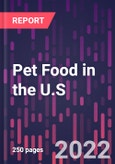In the previous edition of this report, the big question was how the COVID-19 pandemic would affect the pet food market. We now know that the pandemic had a surprisingly positive effect on the pet market as a whole and on pet food in particular, which saw double-digit growth in 2020 and 2021. And the pandemic continues to impact the market, the most visible forces being the record inflation and supply chain disruptions that have driven prices to an all-time high. Other market factors include an increased awareness of health and wellness, the acceleration in online shopping and related behavior, and the solidification of pets' role in the home as family members.
Despite the challenging conditions of the past few years, the pet food market has proven to be as resilient as ever, bolstered by U.S. pet owners' willingness to spend on their beloved “fur babies” even in the midst of a health and economic crisis. With 2021 sales approaching $40 billion, sales of dog and cat food are expected to top $60 billion by 2026, with e-commerce continuing to strengthen its position as the No. 1 retail channel. Featuring updated sales projections and analyses of the trends impacting the market now and into the foreseeable future, this completely revised 16th edition of Pet Foods in the U.S. analyzes the lingering impact of the pandemic including inflation, supply constraints, shopper patterns, and pet owner interest in alternative pet foods.
Providing separate sales tracking and projections for dog and cat food, the report also examines trends by form (dry, wet, semi-moist, frozen/refrigerated, and freeze-/air-dried), ingredients, and product claims across the full retail spectrum including online retailers, mass-market outlets, the pet specialty channel, and other channels. It provides a comprehensive overview covering historical market size and projections (2017-2026); cross-market trends; consumer expenditures; market opportunities; mergers and acquisitions; channel trends including e-commerce and omnichannel; and new product and marketing trends - all presented through the lens of the changes brought on by the pandemic.
Scope and Methodology
Pet Food in the U.S., 16th Edition analyzes the retail market for pet food in the United States. The full retail spectrum is quantified, including mass-market outlets, pet specialty stores (chains and independents), and other channels including the Internet. The report divides the market into two categories:
- Dog Food, subdivided into four forms: Dry, Wet (aka “Canned”), Frozen/Refrigerated, and Semi-moist.
- Cat Food, also subdivided into four forms: Dry, Wet (aka “Canned”), Frozen/Refrigerated, and Semi-moist.
This report also discusses freeze-dried and air-dried formulations, and meal toppers and other pet food add-ins.
Though discussed in context of the market as a whole, pet food sold through the veterinary channel and non-medical petcare service providers is excluded from the market sizing estimates and is instead included in the market sizing for those channels as presented in the annual U.S. Pet Market Outlook reports.
The information contained in the report was obtained from primary and secondary research. Primary research includes consumer data from online surveys with a sample of approximately 1,000-2,000 pet owners that are census representative on the primary demographic measures of age, gender, geographic region, race/ethnicity, presence or absence of children in the household, and household income up through the $100K+ income bracket. This report features data primarily from the publisher's February 2022 and April 2022 surveys.
Primary research also includes data from MRI-Simmons surveys, which are booklet-based and fielded on an ongoing basis. The study releases cited in this discussion represent roughly 12-month data roll-ups, with the survey releases named based on the season in which the fielding ended, rather than calendar years or standard seasonal periods. Field dates for the most current Spring 2022 survey were March 2021 through May 2022, while field dates for the preceding Spring 2021 survey were August 2020 through May 2021. As reflected in textual discussion and in the corresponding table or figure titles, therefore, MRI-Simmons Spring 2022 survey release data are best described as 2021/22 figures, and Spring 2021 data as 2020/21 figures, and so forth with historically trended data.
The primary research also includes interviews with pet market experts; participation in pet industry events including the American Pet Products Association's Global Pet Expos and Petfood Industry/Watt Publishing's Petfood Forums; on-site examination of retail and service provider venues; and Internet canvassing, including blogs. Secondary research includes information- and data-gathering from consumer business and trade publications including Pet Age, Pet Business, Pet Product News International, Petfood Industry, and Petfood Processing; company profiles in trade and consumer publications; and information culled from the publisher's extensive pet market research database and report collection.
The publisher's estimates of market size and company performance are based on reported revenues of pet product manufacturers and retailers; background sales data from sources such as IRI and Nielsen; surveys of independent and chain pet store retailers; government data including U.S. Bureau of Labor Statistics Consumer Expenditure Surveys; and figures from other market research sources.
Table of Contents
Companies Mentioned
- Amazon
- AnimalBiome
- Apax Funds
- Arbor
- Cargill
- Champion Petfoods
- Diamond Pet Foods
- FountainVest Partners
- Kainos Capital
- Kinderhook Industries
- KKR
- Maev
- Mars
- Mid America Pet Food
- Muenster Milling Company
- Natural Balance
- Natural Pet Food Group
- Nature’s Logic
- Nestlé
- NomNomNow
- Nulo
- NXMH Whitebridge Pet Brands
- Open Farm
- Pet Food Experts
- PetCo
- PetPlate
- Primal Pet Foods
- Royal Canin
- Smucker’s
- Target
- United Pacific Pet
- Walmart
- Wellness Pet Company
- Ziwi Ltd








